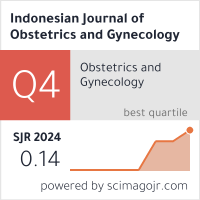Transvaginal Ultrasound Assessment of Cervical Length in Threatened Preterm Labor
Abstract
Objectives: To determine the cut off point of cervical length using
transvaginal ultrasonography to predict the actual occurrence of
preterm labor in women with threatened preterm labor.
Methods: A cross sectional study with consecutive random sampling
method. We examined 80 women with singleton pregnancy
complaining of regular, painful uterine contraction and ruptured
membrane at 24-36 weeks of gestation. Women in active labor, defined
by the presence of cervical dilatation less than or equal 3 cm, and having complication
were excluded. When the patient was admitted, a transvaginal
scan was performed to measure the cervical length. Parenteral
magnesium sulfate was given as the subsequent management.
The primary outcome was delivery within 24 hours of presentation.
Results: We found that the optimal cut off values for cervical length
was 2.65 cm with sensitivity 94.4 Percent, specificity 65.4Percent, positive predictive
value 75.4 Percent and negative predictive value 81.8 Percent. In 69
cases, the cervical length was more than or 2.65 cm, with 52 patients successfully
continued their pregnancy until more than 24 hours. In the 11
cases with cervical length less than or equal 2.65 cm, delivery within 24 hours occurred
in 9 cases (81,8 Percent).
Conclusion: The findings of this study suggest that in women with
threatened preterm labor, cervical length more than or equal 2.65 cm may help predict
the actual occurrence of preterm labor.
Keywords: cervical length, threatened preterm labor, transvaginal
ultrasonography
Downloads
Copyright (c) 2020 Indonesian Journal of Obstetrics and Gynecology

This work is licensed under a Creative Commons Attribution-NonCommercial-ShareAlike 4.0 International License.













